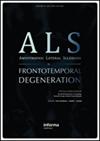Theme 2 Genetics and genomics
IF 2.5
4区 医学
Q2 CLINICAL NEUROLOGY
Amyotrophic Lateral Sclerosis and Frontotemporal Degeneration
Pub Date : 2019-10-31
DOI:10.1080/21678421.2019.1646990
引用次数: 0
Abstract
Background: A genetic basis is found in ∼70% of familial and ∼15% of sporadic ALS, in research cohorts. Clinical trials of gene-targeted therapies are underway, heralding a new era of personalized medicine in ALS treatment. However, ALS management guidelines do not include recommendations for the offer of genetic testing. Many persons with ALS who desire genetic testing are not currently offered it, and the yield of genetic testing in clinic-based ALS populations is unknown. The ALS GAP program, sponsored by the Northeast ALS (NEALS) Consortium, provides free genetic testing for patients with ALS who have a family history of ALS or dementia. We report genetic testing outcomes in the first 142 patients tested in the program.Objectives: 1) To create a pilot ALS genetic testing program for NEALS clinics, 2) To study the rate of ALS gene identification in a US clinic-based populationMethods: Persons with ALS and a family history of ALS (fALS) or dementia (dALS) who receive care at a US NEALS clinic are eligible for testing. Patients classified as fALS (having a positive family history of ALS in a 1st, 2nd, or 3rd degree relative) are eligible for C9orf72 testing, with the option to reflex to a 5 gene (SOD1, FUS, TARDBP, TBK1, VCP) panel. Patients classified as dALS (having a positive family history of dementia of any type in a 1st or 2nd degree relative) are eligible for C9orf72 testing only.Results: Currently, 29.5% (34/115) of US NEALS clinics have participated in the program. Of 142 patients who have completed testing to date, 78 (54.9%) were classified as fALS and 64 (45.1%) as dALS. Among fALS cases, 42/78 (53.9%) tested positive, including 32/78 (41%) with a C9orf72 repeat expansion, and 10/78 (12.8%) with other pathogenic or likely pathogenic variants in SOD, FUS, TARDP or VCP. Variants of uncertain significance (VUS) in FUS were identified in 2/78 (2.6%). Among dALS cases, 12/60 (20%) tested positive for C9orf72.Discussion and conclusions: Participation in ALS-GAP indicates significant clinician and patient interest in ALS genetic testing. This program addresses several current barriers to testing access, including cost, identifying appropriate candidates for testing, and appropriate test selection. Although 38% of patients who participated in the program have thus far received a genetic diagnosis, our testing outcome data suggests that the gene identification rate in fALS cases may be lower in clinic-based patients than in research cohorts, particularly for genes other than C9orf72. This program may serve as a model for the practice of ALS genetic testing in the clinic setting. Consistent, equitable testing policies, as well as an accurate understanding of the genetic profile of clinic-based ALS populations, are needed as gene-targeted therapies reach patient care.主题2遗传学和基因组学
背景:在研究队列中,约70%的家族性ALS和约15%的散发性ALS存在遗传基础。基因靶向治疗的临床试验正在进行中,预示着ALS治疗的个性化医学新时代的到来。然而,ALS管理指南不包括提供基因检测的建议。许多希望进行基因检测的ALS患者目前还没有得到这样的服务,而且基因检测在临床ALS人群中的效果尚不清楚。ALS GAP项目由东北ALS协会(NEALS)赞助,为有ALS或痴呆家族史的ALS患者提供免费的基因检测。我们报告了在
项目中测试的前142名患者的基因检测结果。目的:1)为NEALS诊所建立一个ALS基因检测试点项目;2)研究美国临床人群中ALS基因鉴定率。方法:在美国NEALS诊所接受治疗的ALS患者和ALS家族史(fALS)或痴呆(dALS)患者有资格进行检测。被归类为fALS的患者(有1、2或3度亲属有ALS阳性家族史)有资格进行C9orf72检测,并可选择对5个基因(SOD1、FUS、TARDBP、TBK1、VCP)进行反射。被归类为dALS的患者(在一级或二级亲属中有任何类型的阳性痴呆家族史)仅适用于C9orf72检测。结果:目前,29.5%(34/115)的美国NEALS诊所参与了该项目。迄今为止完成检测的142例患者中,78例(54.9%)被分类为fALS, 64例(45.1%)被分类为dALS。在fALS病例中,42/78(53.9%)检测呈阳性,其中32/78(41%)为C9orf72重复扩增,10/78(12.8%)为SOD、FUS、TARDP或VCP的其他致病或可能致病变异。在2/78(2.6%)中发现了FUS的不确定意义变异(VUS)。在dALS病例中,12/60(20%)的C9orf72检测呈阳性。讨论和结论:参与ALS- gap表明临床医生和患者对ALS基因检测有重要的兴趣。该计划解决了目前测试访问的几个障碍,包括成本,确定适当的测试候选人,以及适当的测试选择。虽然目前参与该项目的患者中有38%接受了基因诊断,但我们的测试结果数据表明,临床患者的fALS病例的基因识别率可能低于研究队列,特别是对于C9orf72以外的基因。本项目可作为临床ALS基因检测实践的典范。随着基因靶向治疗进入患者护理,一致、公平的检测政策以及对临床ALS人群基因谱的准确理解是必要的。
本文章由计算机程序翻译,如有差异,请以英文原文为准。
求助全文
约1分钟内获得全文
求助全文
来源期刊

Amyotrophic Lateral Sclerosis and Frontotemporal Degeneration
CLINICAL NEUROLOGY-
CiteScore
5.40
自引率
10.70%
发文量
64
期刊介绍:
Amyotrophic Lateral Sclerosis and Frontotemporal Degeneration is an exciting new initiative. It represents a timely expansion of the journal Amyotrophic Lateral Sclerosis in response to the clinical, imaging pathological and genetic overlap between ALS and frontotemporal dementia. The expanded journal provides outstanding coverage of research in a wide range of issues related to motor neuron diseases, especially ALS (Lou Gehrig’s disease) and cognitive decline associated with frontotemporal degeneration. The journal also covers related disorders of the neuroaxis when relevant to these core conditions.
 求助内容:
求助内容: 应助结果提醒方式:
应助结果提醒方式:


